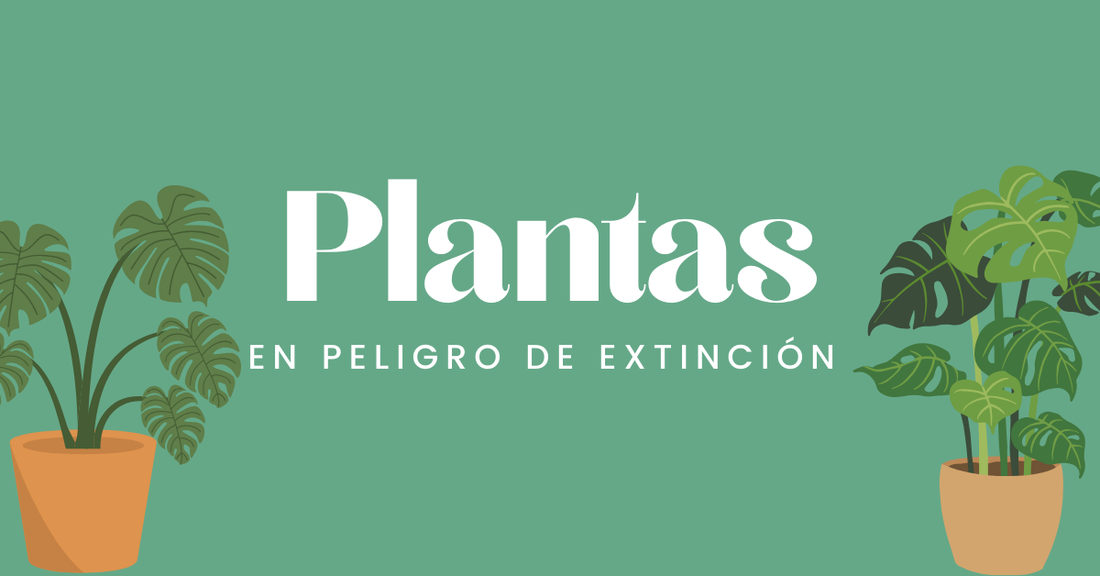Concern for endangered plants is crucial not only for botanists and conservationists, but for all of us, as the loss of these species can affect the ecological balance and global biodiversity. If you'd like to learn more about how we can address this challenge and what actions you can take to help, read on.
Main Causes
Habitat Destruction
Habitat destruction is one of the main threats to endangered plants. Urban expansion, deforestation, and land conversion for agriculture have drastically reduced the natural areas where these plants can grow. Without suitable habitat, many species cannot survive and face the risk of extinction.
Habitat loss affects not only individual plants but the entire ecosystem of which they are a part. The alteration of the natural environment can affect pollinators, such as bees and butterflies, and other organisms that depend on plants for their survival, creating a knock-on effect that threatens biodiversity overall.
Climate Change
Climate change also plays a crucial role in the threat to endangered plants. Alterations in weather patterns can alter plant growth and flowering cycles. Extreme temperatures, prolonged droughts, and extreme weather events can affect plant health and reproduction.
Furthermore, climate change can promote the spread of pests and diseases that affect plants, exacerbating the risk of extinction. Species that cannot adapt to new climatic conditions face a greater likelihood of extinction.
Human Activities
Human activities are another significant factor in the risk of plant extinction. Air and water pollution, as well as the introduction of invasive species, can have a negative impact on native plants. These activities alter ecosystems and can lead to the disappearance of species that cannot compete with the new conditions.
Overexploitation of plants for commercial uses, such as over-collection for gardening and medicine, also contributes to their risk of extinction. Demand for these plants can outstrip their regeneration capacity, reducing wild populations.
Examples of Plants in Danger of Extinction
Norfolk conifer (Araucaria heterophylla)
The Norfolk Island conifer , native to Norfolk Island in the Pacific, is an endangered plant due to habitat loss and collection for the ornamental plant trade. This species is known for its distinctive shape and needle-like leaves, which make it highly prized in gardening.
To protect the Norfolk Island conifer , conservation efforts have been established in its natural habitat, and nursery breeding programs are underway to reintroduce it to the wild. Habitat conservation and regulation of the plant trade are crucial to ensuring its survival.
Giant Lotus Flower
The giant lotus flower , known for its enormous floating leaves and stunning blooms, is an endangered plant found in the Amazon wetlands. Deforestation and wetland destruction have significantly reduced the available land area for this plant.

To protect the giant lotus , conservation efforts are underway in its habitat wetlands, and sustainable practices are being promoted to preserve these critical ecosystems. Protecting wetlands is essential for the survival of this species and the many other plants and animals that depend on them.
Saguaro Cactus (Carnegiea gigantea)
The saguaro cactus is an iconic species of the Sonoran Desert in North America. Although known for its impressive size and longevity, this plant faces threats due to climate change, illegal harvesting, and urban expansion.

Efforts to protect the saguaro cactus include the creation of protected areas and the implementation of regulations to prevent illegal collection. Additionally, monitoring and restoration programs are helping to ensure that cactus populations remain healthy and sustainable.
How We Can Help Conserve Endangered Plants
Support Conservation Initiatives
Supporting conservation initiatives is one of the most effective ways to help protect endangered plants. There are numerous organizations and programs dedicated to plant and habitat conservation. You can contribute to these efforts through donations, volunteering, or participating in fundraising events.
These organizations work on habitat protection projects, ecosystem restoration, and educational programs that promote awareness about the importance of conserving our endangered plants. Your support can make a big difference in the preservation of these species.
Promote Education and Awareness
Education and awareness are powerful tools in plant conservation. Informing others about the importance of these species and the threats they face can help increase support for their preservation. You can participate in educational campaigns, share information on social media, and organize community events to promote conservation.
Education about local and global flora also helps create a greater appreciation for biodiversity and fosters a sense of responsibility in protecting endangered plants.
Choosing Sustainable Products and Services
Opting for sustainable products and services can have a positive impact on plant conservation. When purchasing plants for your garden, choose those grown responsibly and avoid purchasing rare species from unverified sources. Supporting companies that practice sustainable agriculture and promote the conservation of natural habitats can also contribute to the protection of endangered plants.
Additionally, consider participating in local initiatives that promote habitat restoration and reforestation. These actions not only benefit endangered plants but also help improve the overall health of the ecosystem.
What does it mean for a plant to be in danger of extinction?
A plant is endangered when its population in the wild is declining and it faces a high risk of disappearing. This can be due to factors such as habitat loss, climate change, pollution, or overexploitation.
How are endangered plants identified?
Endangered plants are often identified and classified by organizations such as the International Union for Conservation of Nature (IUCN). These organizations maintain lists of endangered species and provide information on their conservation status and the threats they face.
What organizations work on the conservation of endangered plants?
There are several organizations dedicated to plant conservation, such as Botanic Gardens Conservation International (BGCI), the IUCN, and various local NGOs in regions with high biodiversity. These organizations carry out habitat protection projects, restoration programs, and awareness-raising campaigns.
How can I get involved in the conservation of endangered plants?
You can get involved in the conservation of endangered plants by supporting initiatives and organizations dedicated to protecting these species. Consider donating, volunteering, educating others about the importance of conservation, and adopting sustainable practices in your daily life.








